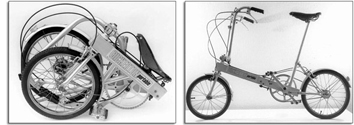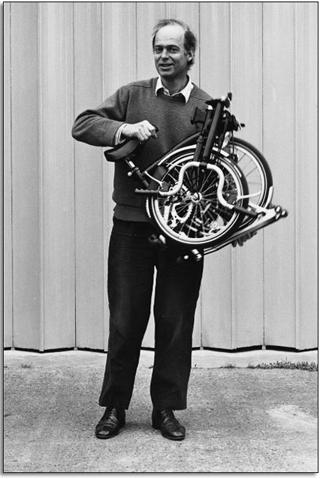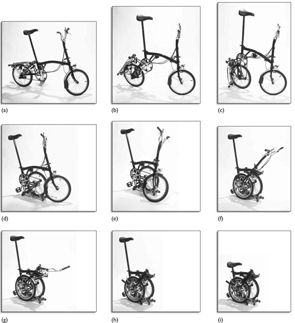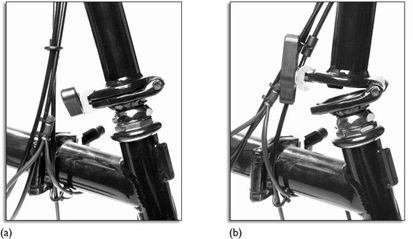6 Design and innovation 3: the Brompton folding bicycle
6.2 Bicycle origami
Andrew Ritchie started designing a folding bicycle in 1975, stimulated by the Bickerton folding bicycle design. The Bickerton (Figure 44) is made from aluminium, and is hinged at the chainwheel bracket. (The chainwheel is the toothed wheel driven by the pedals.) This means that the chain and chainwheel are on the outside when the bicycle is folded, and the two wheels come together.
In essence, Ritchie was inspired by the thought that he could do better. His two major criticisms were that the bicycle didn't fold well because the chainwheel, the muckiest part of a bicycle, was prominent; and that he did not think that aluminium was the best material for a folding bike:
Aluminium is too soft for a folding bicycle, it just doesn't stand up to the knocks, the everyday wear and tear.
The first criticism is easy to accept, but his view on aluminium is not at all obvious. After all, many bicycles are made from aluminium, which is a light, corrosion-resistant material, seemingly ideal for a portable bicycle. If it is good enough for top-of-the-range cars like the Aston Martin V12 Vanquish, why not for a bicycle also? Remember that its corrosion resistance and low weight made it a good choice for the Res-Q-Rail. I shall return to this issue later.
In an existing firm, say a bicycle company, an idea for a new product such as this would include other people in critical roles. Perhaps market researchers, involving bicycle users, to estimate the size of the potential market and the interaction between designers with technical expertise in, say, production and structures. Cost would play a large part in the discussions, as would risk and the effect of the project on existing products and commitments.
An independent designer can often find it difficult to get a sympathetic hearing when they take their ideas to established manufacturers. They face the ‘not invented here’ syndrome, which suggests that companies put their faith in their own in-house ideas but cannot see the potential in ideas from outside. Alternatively, they see potential legal and economic problems in protecting and investing in a design which may have been shown to competitors. This is a common enough story: the Dyson vacuum cleaner was hawked around established vacuum cleaner companies who rejected the idea. Andrew Ritchie was to experience the same rejection from bicycle manufacturers.
His basic idea, which remained constant through the development of prototypes, was to hinge the bicycle to make the wheels come to the ‘centre’, one on each side of the chainwheel. In this way the wheels would shroud the oily chain and chainwheel.
Such a ‘kinematic’ solution (referring to the way that the parts of the bicycle move relative to each other) occupies a different design space from that of the Bickerton. It gives the same functional solution – reducing the length of the bike down to something which is more portable – but the way by which this is achieved is different. The concept of where the bicycle is hinged, and how its parts are arranged when folded is different. Once that concept is established a way of realizing it is required.
By way of introduction to the Brompton story, Figure 46 shows a recent production Bromption being folded. The first stage is to swing the rear wheel underneath the frame – see pictures (a) to (d). As you can see, the wheel hinges in its own plane.
The next stage is to move the front wheel to a position alongside the rear wheel; pictures (e) and (f). This is done by freeing a clamp on the frame crossbar, near where the crossbar joins the headstock. (The headstock is the part of the frame to which the handle-bar pillar and the front wheel are attached.) Once the clamp is freed, the front of the frame can be hinged sideways to bring the front wheel beside the rear wheel. This sideways movement of the front end is a significant feature of the production model. As we shall see, the first prototype Brompton used a different technique
Another clamp, just above the headstock (Figure 47), is freed, allowing the handle-bar pillar to hinge down to sit alongside the front wheel; pictures (g) and (h).
The final step is to unclamp the seat pillar and to slide the seat down; picture (i). This action locks the bicycle into its folded arrangement.
In Figure 47(a), the clamped crossbar hinge is visible behind the bundle of cables. This hinge, when unclamped, allows the front wheel to be moved to a position alongside the rear wheel, as in Figure 46 (e) and (f).
Bicycles designed to be folded into a convenient shape have a long and honourable history going back at least as far as 1885. Figure 48 is a collage of a few of the many solutions to the problem. Common to all these designs (and the Bickerton in Figure 44) is the problem of the protruding chainwheel, so Ritchie's concept looks to be a genuine innovation.




